 Kia Optima: Description and Operation
Kia Optima: Description and Operation
System Overview
RPAS(Rear Parking Assist System) is an electronic driving aid device warning driver
to be cautious when they park or speed low after detecting an object on side and
behind of vehicle by using the feature of ultrasonic waves.
RPAS consists of four
RPS sensors which are detecting the obstacles and transmit the result separated
into three warning levels, the first, second and third to BCM by Lin communication.BCM
decides the alarm level by the transmitted communication message from the slave
sensors, then operate the buzzer or transmits the data for display.

System Block Diagram

System Operation
| 1. |
RPAS checks the ID and Reference
(shaping table) during the initialization using LIN communication. |
| 2. |
If sensor ID or sensor parameter
is same with expected value, RPAS system is initialized within 500ms after
turning IGN1 and shifting R gear. |
| 3. |
If Sensor ID or sensor parameter
is different with expected value, initial mode can take about 1.2 second
after turning IGN1 and shifting R gear because of teaching sensor ID or
sensor parameter. |
| 4. |
RPAS executes the diagnosis of
each sensor during the initialization.
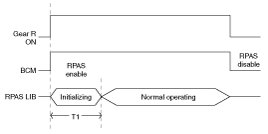
T1 : RPAS initializing time
| (1) |
In case of sensor teaching,
T1 : within 1.2 second |
| (2) |
In case of normal condition,
T1 : 500ms ± 10% |
|
Normal mode of RPAS can divide as two steps.
First step is a mode to inform the driver of the RPAS system ON and diagnosis
results which is executed during the initialization.
Second step is the obstacle detection mode to give driver warning when detecting
the obstacle.
| 1. |
Driver info mode for RPAS ON
| (1) |
If there aren’t any diagnosis
messages from sensors, the normal RPAS ON sound with ON-period 300ms
warn after initializing time since R gear is shifted. The obstacle
detection warning starts after the delay of 100ms since finishing
the normal RPAS ON warning sound.

|
| (2) |
If there are any failure
sensor, “Warning of sensor fail” sound is driven during the fixed
period and if there is any display unit, it displays the diagnosis.
Refer to the Diagnosis buzzer sound for more detail Information.
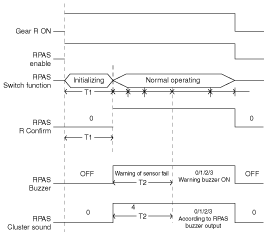
T1 : RPAS initializing time
| (1) |
In case of sensor
teaching, T1 : within 1.2 second |
| (2) |
In case of normal
condition, T1 : 500ms ± 10% |
T2 : Refer to the spec for warning of fail |
| (3) |
“Diagnosis-buzzer” is
driven only one time but the display unit continue to display the
diagnosis according each failure sensor’s location. |
|
| 2. |
Obstacle detection mode
| (1) |
There are 3 kinds of
warning sound for detecting the obstacle, the 1st warning and the
2nd warning are the intermittent sound and the 3rd warning is the
continuous sound. |
| (2) |
The vehicle speed for
the operation of RPAS is below 10Km/h . |
| (3) |
There are 2 kinds of
detection mode. One is for normal operating mode using normal 4
sensors. Even if any sensor is on failure condition, the RPAS system
will be entered to degrade mode excepting a failure sensor. |
| (4) |
Operating procedure
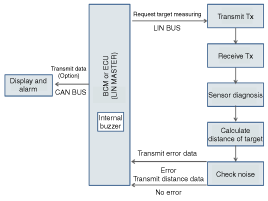
|
|
| 1. |
Test condition – PVC pole(Diameter
75mm, Length 1m) & At the room temperature |
| 2. |
Distance tolerance (measured
at the front of sensor) 81 cm ~ 120 cm : ± 15 cm
41 cm ~ 80 cm : ± 10 cmBelow 40 cm : ± 10 cm
|
| 3. |
Below 30 cm may not be detected. |
| 4. |
Sensing zone specification
Sound pulse has a fixed duration.
Pause between pulses is related to the distance from the obstacle and is
not variable.Although the position of the obstacle is not moving during
sometime, the buzzer should keep warning. And although an obstacle that
is currently warned is getting far, the buzzer should keep warning according
to obstacle distance.
The warning sound is generated by the algorithm of ECU which measures the
distance of the obstacle from the sensor.The distance is divided into
three detection ranges. Obstacles below 30cm from the sensor may not be
detected.
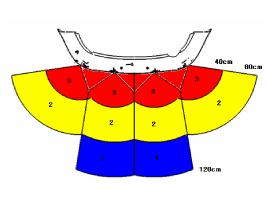
|
Each Warning Zone Hysteresis Function for buzzer and display.
Condition
|
1st Warning (120cm)
|
2nd Warning (80cm)
|
3rd Warning (40cm)
|
the distance between vehicle and obstacle is getting close
|
Immediately warning
|
the distance between vehicle and obstacle is getting far
|
2sec warning delay
|
2sec warning delay
|
1sec warning delay
|
If RPAS sensor detects the obstacle, the acoustic device makes warning sound and
the display module (Cluster) indicates each warning level as like followings.
RPAS sensor sends the distance data to BCM through LIN communication and BCM received
the distance data from each sensor.
BCM has the responsibility of the acoustic function.
BCM has the responsibility
of the gateway function that BCM sends the warning data to Cluster as like below
timing diagram.

When change from a warning area to the different zone, after finishing one cycle
of warning output, the next warning sound has to start for different zone necessarily.
| Timing Chart for RPAS Warning Sound |
If Power is supplied to the system (turning IGN1 and shifting R gear), BCM checks
the channel of each sensor and if no problems, the buzzer sound with turn-on period
300ms is generated after 500ms, but even if one sensor has a problem, the buzzer
sound not for “Start-buzzer of RPAS” but for “Diagnosis-buzzer of RPAS”, The next
action for Normal mode is like followings.
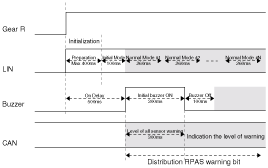
After R gear is armed, the system operation is like followings.
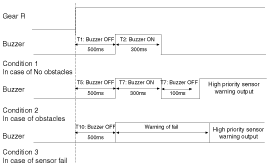
Time tolerance: ±10%
After R gear is disarmed, the system operation is like followings.
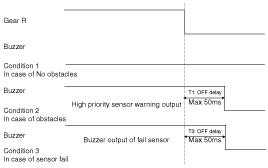
Time tolerance: ±10%
| Sensor interval distance dividing alarm
output specification |
The condition logic is as below according to phase logic in priority. (In same sensor)

RPAS operation ranges according to distance are as below.
| 1. |
First alarm (81 cm ~ 120 cm)

|
| 2. |
Secondary alarm (41 cm ~ 80 cm)

|
| 3. |
Third alarm (40 cm or less)

|
| 4. |
Failure alarm cycle
When the system starts and sensor has errors, the warning sound as the
sensor position is like following.

※ In the case that the multiple sensors have errors, the sequence of sensor’s
warning is like followings.RL → RCL → RCR → RR

※ After the warning sound for diagnosis is generated, the other normal sensors
execute the normal function such as the detection and the transmission of
distance data.
| 1. |
Time tolerance
of the above waveform : Time ± 10% |
| 2. |
At nearer distance
than 30cm, detection may not occur. |
| 3. |
Alarm will be
generated with vehicle reversing speed 10km/h or less.
|
| 4. |
For moving target,
maximum operation speed shall be target approach speed of
10km/h. |
| 5. |
When the vehicle
or the target is moving, sequential alarm generation or
effective alarm may be failed. |
| 6. |
False alarm,
or failure of the alarm to trigger may occur in the following
conditions. |
| -
|
Irregular road
surface, gravel road, reversing toward grass. |
| -
|
Horn, motor cycle
engine noise, large vehicle air brake, or other object generating
ultrasonic wave is near. |
| -
|
When a wireless
transmitter is used near to the sensor. |
| -
|
Sequential alarm
may not occur due to the reversing speed or the target shape.
|
|
|
■ LIN BUS Off error
Division
|
Condition for error
|
Condition for the disarmed
|
Initial routine
|
Detecting LIN BUS OFF one time
|
Disarmed (if LIN BUS ON is detected 4 consecutive times in general routine)
|
Normal routine
|
Detecting LIN BUS OFF 4 consecutive times
|
Disarmed (if LIN BUS ON is detected 4 consecutive times)
|
※ Remarks
| 1. |
LIN BUS OFF means no response
from sensors when BCM send request to sensors. |
| 2. |
In the case that error happens
to the initial routine, diagnosis warning sound + display for error |
| 3. |
In the case that error happens
to the Normal routine, the only display for error |
| 4. |
If error happens to the direct
condition of each sensor, after that, error is transmitted at the indirect
condition (sensor side). |
■ In the case of sensor error
Division
|
Condition for error
|
Condition for the disarmed
|
Initial routine
|
Detecting the message of sensor error
|
Disarmed(if the message which sensor is normal is detected 4 consecutive
times , but it is impossible to be disarmed in the initial routine)
|
General routine
|
Detecting the message of sensor error 4 consecutive times
|
Disarmed(if the message which sensor is normal is detected 4 consecutive
times)
|
※ Remarks
| 1. |
In the case of fault counting
output message or signal with last valid should be transmitted. |
| 2. |
In the case that error happens
to the initial routine, diagnosis warning sound + display for error |
| 3. |
In the case that error happens
to the general routine, the only display for error |
Component Location
1. BCM
2. Ultrasonic sensor
3. Buzzer
※ Rear parking assist control unit function and buzzer are built in BCM
(bod ...
See also:
Removal
1.
Remove the radiator grill upper
cover.(Refer to the BD group - "Front bumper")
2.
Remove the mounting nut and disconnect
the horn connector (B), then ...
Heating and air conditioning
1. Start the engine.
2. Set the mode to the desired position. To improve the effectiveness of heating
and cooling :
- Heating: - Cooling:
3. Set the temperature control to the desired position.
...
Multimedia jack. Schematic Diagrams
Circuit Diagram
...
 Kia Optima: Description and Operation
Kia Optima: Description and Operation






 Components and Components Location
Components and Components Location










